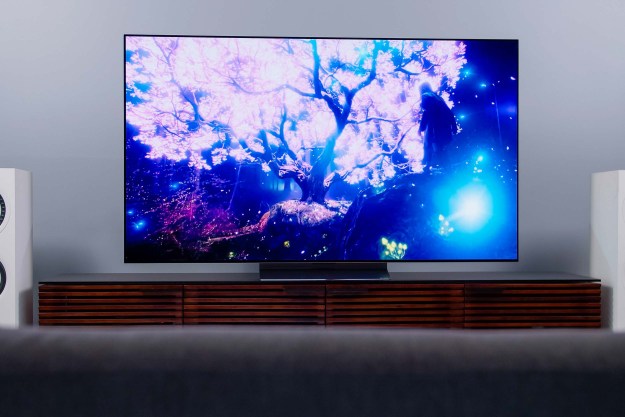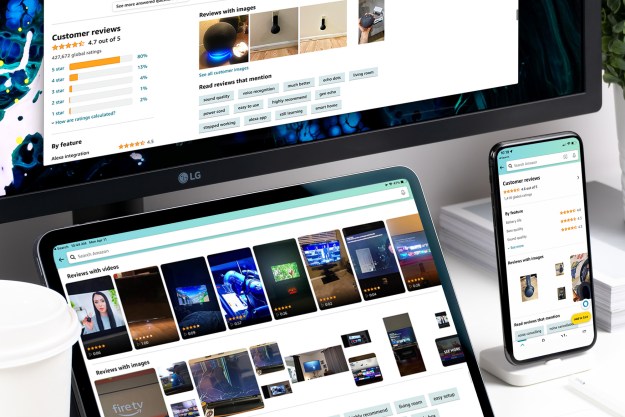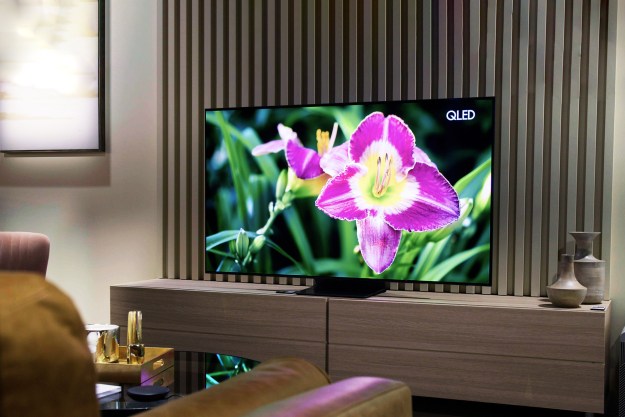“Remote controls are supposed to be rectangular, and there's just no good reason for this one to look like a donut.”
- Doesn't rely on a surface to operate; no line-of-sight requirement; vertical scroll wheel
- Odd form factor; uses disposable batteries; no transport-control buttons; can't control other A/V components
Summary
Question: How do you point with a circle? Answer: It’s a trick question – you can’t point with a circle. Fortunately for Hillcrest Labs, designers of the Loop Pointer, you don’t actually need to point the device to control the cursor on your home theater PC, PlayStation 3, or Apple TV.
The goofy-looking, doughnut-shaped remote control is easy to use from your couch or recliner because it has no line-of-sight requirement and doesn’t depend on any surface to operate. It uses micro-electro-mechanical systems (MEMS) sensors to track motion with six degrees of freedom. And aside from the Apple TV (which must have Fire Core’s aTV Flash software), you don’t need to install any software on the machine you wish to control – just plug in the USB receiver and you’re good to go. Hold the Loop Pointer in front of you, tilt your wrist up or down, and the cursor on the screen moves up or down; twist your wrist left or right and the cursor follows suit. Right and left mouse buttons and a scroll wheel enable you to interact with the graphical user interface of whatever device the Loop Pointer is plugged into (it’s compatible with the Windows, Linux, and Macintosh operating systems). Note to PS3 users, though: The Loop Pointer controls the user interface only… you can’t use it for actual gameplay.

The Loop Pointer is most useful in environments where a conventional mouse isn’t practical, such as a home theater, or when you’re running a slide show or a PowerPoint presentation. We tested it with a home theater PC connected to a 42-inch ViewSonic N4285 LCD television and found it to be far superior to a mouse, but not nearly as versatile as a competing device, Gyration’s Media Center Universal Remote Control, which uses similar technology and sells for about the same price.
Got a drawer full of remote controls for your home entertainment system? You’ll never confuse the Loop Pointer with anything else in there, but it will never replace any of those devices, either. Being limited to two buttons and a scroll wheel means all you can do is point at objects on the screen and click. Since the pointer doesn’t have transport-control buttons, for instance, you can’t press one button to pause movie or music playback. You have to wiggle the remote to wake up the Loop Pointer and render the on-screen transport controls visible, and then flick your wrist to move the cursor to the appropriate on-screen button and click. Other simple tasks, such as controlling the volume or changing a channel on a PC’s TV tuner, are similarly difficult because you must manipulate the GUI to do everything.

Gyration’s remote, by comparison, not only has media transport buttons (play, pause, reverse, etc.) and volume control, it also has dedicated buttons for launching a web browser, email client, or other application (including Windows Media Center); a telephone-style numeric keypad; and more. And being a true universal remote, you can program it to control your TV, A/V receiver, and other home-theater components, too.
Both the Gyration and the Loop Pointer enabled us to control the mouse cursor with about the same degree of precision, but the presence of a scroll wheel on the latter rendered a few tasks, such as web surfing, much easier. Scrolling a web page on the Gyration, for instance, involves the awkward exercise of holding down the left mouse button while tilting the remote to drag the browser window’s vertical scroll bar. With the Loop Pointer, you just spin the scroll wheel with your index finger, just as you would with a better-quality conventional mouse.
Conclusion
Truth be told, however, we’ve had the Gyration remote in our home test lab for more than six months, and cursor control is the only task we’ve ever used it for anyway. (When it comes to universal remote controls, it’s hard to beat Logitech’s Harmony 1100. The presence of a scroll wheel renders the Loop Pointer far more effective in this regard. Even so, it took us a long while to grow accustomed to its circular form factor. Oh well, maybe we’re just industrial design bigots: Remote controls are supposed to be rectangular, and there’s just no good reason for this one to look like a donut.
Pros:
- Doesn’t rely on a surface to operate
- No line-of-sight requirement
- Vertical scroll wheel
Cons:
- Odd form factor
- Uses disposable batteries
- No transport-control buttons
- Can’t control other A/V components
Editors' Recommendations
- JLab jumps into hi-res and Bluetooth LE audio with $200 Epic Lab Edition earbuds
- Samsung S95C OLED hands-on review: it’s time to get excited
- Edifier MP230 Hands-on Review: The pint-sized, retro Bluetooth speaker brings a vintage vibe
- Sonos Voice Control hands-off review: Now we’re talking
- The best time-loop movies and TV episodes


